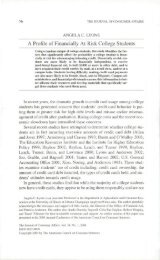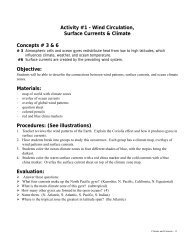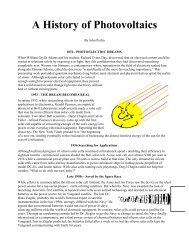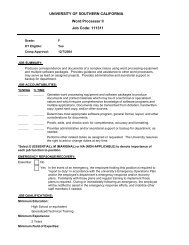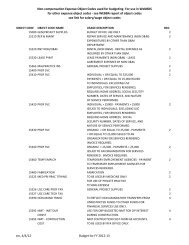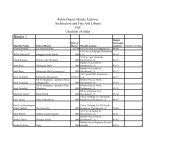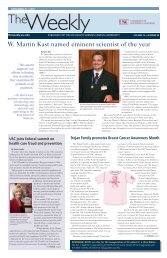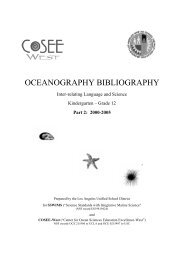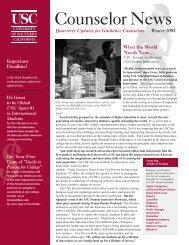USC Thornton Concert Choir - University of Southern California
USC Thornton Concert Choir - University of Southern California
USC Thornton Concert Choir - University of Southern California
Create successful ePaper yourself
Turn your PDF publications into a flip-book with our unique Google optimized e-Paper software.
<strong>USC</strong> <strong>Thornton</strong><br />
<strong>Concert</strong> <strong>Choir</strong><br />
Friday, April 1, 2011, 8:00 p.m.<br />
<strong>University</strong> <strong>of</strong> <strong>Southern</strong> <strong>California</strong><br />
Alfred Newman Recital Hall<br />
Sentiments <strong>of</strong> Life<br />
Cristian Grases, conductor<br />
Seth Houston, assistant conductor<br />
ChoEun Lee, pianist
Program<br />
Esteban López Morago<br />
(c. 1575-1630)<br />
Vic Nees<br />
(b. 1936)<br />
De pr<strong>of</strong>undis<br />
De pr<strong>of</strong>undis<br />
Rodolfo Halffter Tres Epitafios<br />
(1900-1987) Para La Sepultura de Don Quijote<br />
Para La Sepultura de Dulcinea<br />
Quinn Middleman, alto<br />
Yohan Partan, tenor<br />
Para La Sepultura de Sancho Panza<br />
Johann Sebastian Bach Cantata No. 12, “Weinen, Klagen, Sorgen, Zagen,”<br />
(1685-1750) BWV 12<br />
Sinfonia<br />
Chorale<br />
Recitative (alto)<br />
Aria (alto)<br />
Aria (bass)<br />
Aria (tenor)<br />
Chorale<br />
Eleni Pantages, alto<br />
John Russell, tenor<br />
Nicholas Volkert, bass<br />
Jessica Ryu, violin I<br />
Jack McFadden Talbot, violin II<br />
Sixto Franco Chordá, viola<br />
Yoshi Masuda, cello<br />
Gabrielle Castriotta, oboe<br />
TJ Tesh, trumpet<br />
ChoEun Lee, harpsichord<br />
The use <strong>of</strong> flash cameras, video cameras, and other recording devices<br />
is not permitted. Please turn <strong>of</strong>f all cell phones.<br />
Due to safety considerations, members <strong>of</strong> the audience<br />
are not allowed backstage prior to or following performances.
intermission<br />
Felix Mendelssohn Andenken, Op. 100, no. 1<br />
(1809-1847) Seth Houston, conductor<br />
Johannes Brahms Der Abend, Op. 62, no. 2<br />
(1833-1897)<br />
Claude-Achille Debussy Trois chansons de Charles d’Orléans<br />
(1862-1917) Dieu! qu’il la fait bon regarder<br />
Quant j’ai ouy le tabourin<br />
Quinn Middleman, contralto<br />
Yver, vous n’estes qu’un villain<br />
Alexandra Corley, Ashley Luo, Tara José, Quinn<br />
Middleman, Brian Hayes, Yohan Partan, Philip Cho,<br />
and Nicholas Volkert, octet<br />
Morten Lauridsen<br />
(b. 1943)<br />
David Dickau<br />
(b. 1953)<br />
Alberto Grau<br />
(b. 1938)<br />
Sure On This Shining Night<br />
Stars I Shall Find<br />
Kasar Mie La Gaji<br />
Ludwig van Beethoven Joyful, Joyful<br />
(1770-1827) Nicole Wakabayashi, alto<br />
arr. Mervyn Warren Abram St. Amand Poliak<strong>of</strong>f, tenor<br />
& Roger Emerson Sam Hirsh, piano<br />
Amber Navran, saxophone<br />
Chris Rolontz, bass<br />
Pr<strong>of</strong>. Aaron Serfaty, drums
Program Notes<br />
De pr<strong>of</strong>undis<br />
Esteban López Morago<br />
Esteban López Morago, also known as Estêvão Lopes Morago (c. 1575-1630), was<br />
born in Spain but spent most <strong>of</strong> his life in Portugal. In 1599, he was appointed mestre<br />
de capela at Viseu Cathedral, a position he held for most <strong>of</strong> his career. One <strong>of</strong> the<br />
most important polyphonic composers in Portugal, his publications during his lifetime<br />
included Livro Comum and Vesperal. More recently, many <strong>of</strong> his works were published<br />
in the 1961 collection Obras de Música Religiosa (Portugaliae Musica, vol. 4).<br />
The text <strong>of</strong> De pr<strong>of</strong>undis, from Psalm 130 (Psalm 129 in the Vulgate Bible), speaks <strong>of</strong><br />
great despair: “Out <strong>of</strong> the depths I have cried to thee, O Lord.” Morago’s setting, as<br />
is typical for his music, exploits expressive dissonances—including augmented fourths<br />
and augmented seconds—in a polyphonic context. The piece shifts to a more major<br />
modality for the second verse <strong>of</strong> the psalm, “Lord, hear my voice…”<br />
De pr<strong>of</strong>undis<br />
Vic Nees<br />
Belgian composer and choral conductor Vic Nees, son <strong>of</strong> composer Staf Nees, was<br />
born in 1936. Having studied at the Royal Flemish Conservatory in Antwerp and<br />
Hochschule für Musik und Theater in Hamburg, Nees conducted the Flemish Radio<br />
<strong>Choir</strong> from 1970 to 1996. Other ensembles under his direction have included the<br />
Vokaal Ensemble Philippus de Monte in Mechelen and the Ter Kamerenkoor in<br />
Brussels. Of his many choral and vocal works, his Magnificat (1981) is best known.<br />
Nees’ setting <strong>of</strong> De pr<strong>of</strong>undis is ternary in form. The opening section, which repeats<br />
at the end with an extension, is homophonic. It expands from a hushed pianissimo<br />
in a limited range to a searing climax. The middle section features an anguished fast<br />
melody, in canon, with parallel fifths.<br />
Tres Epitafios<br />
Rodolfo Halffter<br />
Spanish and Mexican composer Rodolfo Halffter (1900-1987) was born in Madrid<br />
to a musical family. His parents were German and Catalan. An informal student <strong>of</strong><br />
Manuel de Falla, Halffter was deeply influenced by avant-garde music <strong>of</strong> the time by<br />
figures such as Debussy and Schoenberg. In the 1930s, he was active in a group <strong>of</strong><br />
composers known as the “Grupo de los Ocho,” or the “Group <strong>of</strong> Madrid.” In 1939,<br />
at the end <strong>of</strong> the Spanish Civil War, he emigrated to Mexico and became a citizen<br />
there. He taught for three decades at the National Conservatory and contributed to<br />
and edited numerous musical journals.
In Tres Epitafios, Halffter set the epitaphs <strong>of</strong> three characters from the 16th- to 17thcentury<br />
writer Miguel de Cervante’s novel Don Quixote. Don Quixote, the title figure,<br />
is a delusional gentleman who fancies himself to be a knight, tilting at windmills<br />
(which he imagines to be giants) in the name <strong>of</strong> chivalric ideals. Chief among these<br />
is his love for his idealized and imaginary beloved, Dulcinea. Quixote is accompanied<br />
in his quests by his sidekick, Sancho Panza. Halffter’s settings, composed between<br />
1947 and 1953, feature modified strophic forms, mostly homophonic writing, mixed<br />
meters, and surprising and beautiful cadences. The second piece in the set has short<br />
solos for soprano and tenor.<br />
Cantata No. 12, “Weinen, Klagen, Sorgen, Zagen,” BWV 12<br />
Johann Sebastian Bach<br />
Johann Sebastian Bach (1685-1750) composed Cantata No. 12, “Weinen, Klagen,<br />
Sorgen, Zagen,” in 1714 for Jubilate Sunday, the third Sunday after Easter, which<br />
fell that year on April 22. Helmuth Rilling has written that the cantata was probably<br />
the second that Bach wrote in fulfillment <strong>of</strong> his obligation to compose one cantata<br />
per month for the Wiemar court. Bach revised the work in 1724 and performed it<br />
in Leipzig on April 30 <strong>of</strong> that year. The cantata is most famous for being the source<br />
<strong>of</strong> the Crucifixus in Bach’s Mass in B minor, which the <strong>USC</strong> <strong>Thornton</strong> Choral Artists<br />
performed in November 2009 under the baton <strong>of</strong> maestro Rilling.<br />
Most <strong>of</strong> the text is probably by Salomo Franck (c. 1659-1725). The third movement<br />
is from Acts 14:22 and the last verse <strong>of</strong> the closing chorale is by Samuel Rodigast<br />
(1649-1708). The cantata opens with an instrumental sinfonia. The second movement<br />
depicts Christ’s torment on the cross with imitative and unrelentingly chromatic<br />
suspensions over a ground bass; this is the movement that Bach reused in his later<br />
mass. Here, but not in the mass, it is punctuated by a more uplifting middle section in<br />
triple time. The third movement, a dark alto recitative, describes the tribulations that<br />
believers must endure before entering God’s kingdom. This is followed by an alto aria<br />
on the text “Cross and crown are joined together/ struggle and treasure are united.”<br />
Bach illustrates this conjoining with a lovely alto-oboe duet. In the fifth movement,<br />
an uplifting bass aria, Bach paints the text—“I will follow Christ”—with imitation in<br />
the violin parts. The sixth movement exhorts believers to remain steadfast in their<br />
faith. Bach introduces the trumpet, rather surprisingly, on the melody <strong>of</strong> “Jesu, meine<br />
Freude.” A symbol <strong>of</strong> royalty, in this case Christ and God, the trumpet soars over the<br />
tenor’s lilting aria. The closing chorale, whose music Bach reused in Cantata No. 100,<br />
affirms believers’ trust in God, no matter what hardships may befall.<br />
Andenken, Op. 100, no. 1<br />
Felix Mendelssohn<br />
Felix Mendelssohn (1809-1847) was a leading composer, conductor, and pianist in the<br />
early Romantic period. A champion <strong>of</strong> early music, Mendelssohn was a major force in<br />
the rediscovery and revival <strong>of</strong> Bach’s music in 19th-century Germany. In keeping with<br />
this interest, Mendelssohn’s overall musical sensibility was more conservative than
some <strong>of</strong> his more progressive contemporaries such as Franz Liszt and Richard Wagner.<br />
Mendelssohn was <strong>of</strong> Jewish descent, although his father converted to Lutheranism<br />
and Felix was baptized in the Lutheran church.<br />
Andenken (Remembrance) is the first <strong>of</strong> four songs for mixed voices published<br />
posthumously in 1852 as Vier Lieder. Mendelssohn composed Andenken on<br />
August 8, 1844, while on vacation in Soden. The text, whose author is unknown,<br />
describes the beauty <strong>of</strong> spring, with budding leaves, blooming flowers, singing,<br />
and laughter. However, spring no longer blooms for the poet because his beloved is<br />
gone. Mendelssohn set the poem in bar form, or AAB, which can be thought <strong>of</strong> as<br />
two verses and a chorus; the verses and chorus end with the same musical material.<br />
Interestingly, the musical form does not reflect the form <strong>of</strong> the poem. Mendelssohn<br />
set the first stanza <strong>of</strong> the poem, which is happy, to exactly the same music as the<br />
second stanza, which shifts from happy to sad.<br />
Der Abend, Op. 62, no. 2<br />
Johannes Brahms<br />
Among the prodigious output <strong>of</strong> choral and vocal masterpieces by Johannes Brahms<br />
(1833-1897) are his many part songs. Some <strong>of</strong> these, like Der Abend, were composed<br />
as vocal quartets, although Brahms was accustomed to such pieces also being<br />
performed by larger ensembles. Der Abend (Evening) is the second in a collection<br />
<strong>of</strong> Drei Quartette (Three Quartets), Op. 62. An die Heimat, which the <strong>USC</strong> <strong>Thornton</strong><br />
<strong>Concert</strong> <strong>Choir</strong> performed last year, is the first song in the cycle. Brahms composed Der<br />
Abend in 1874 and premiered it, along with An die Heimat, in Vienna on February<br />
24, 1875.<br />
The text is by Friedrich Schiller (1759-1805), the great German poet, playwright, and<br />
philosopher who, together with Goethe, spearheaded Wiemar classicism. The poem,<br />
as is typical <strong>of</strong> Wiemar classicism, presents human emotions (which were brought<br />
to the fore in the Sturm und Drang and Romanticism movements) through the<br />
framework <strong>of</strong> classical imagery and form. Such poetry was appealing to Brahms, who<br />
himself expressed the heart-rending passions <strong>of</strong> late romanticism through exquisitely<br />
rendered classically (and Renaissance- and Baroque-) inspired forms.<br />
Trois chansons de Charles d’Orléans<br />
Claude-Achille Debussy<br />
Claude-Achille Debussy (1862-1917) is <strong>of</strong>ten called an impressionist composer,<br />
although he himself disliked the term. A talented pianist, Debussy studied at the<br />
Paris Conservatoire. In 1884, he won the prestigious Prix de Rome and continued his<br />
musical studies in Italy. Debussy was deeply influenced by symbolist poetry and was a<br />
regular guest at Stéphane Mallarmé’s gatherings. His 1894 Prélude à l’après-midi d’un<br />
faune, based on a poem by Mallarmé, established him as one <strong>of</strong> the leading modern<br />
composers <strong>of</strong> the era.
In the first decade <strong>of</strong> the 20th century, French nationalism was a major concern<br />
among French intellectuals. Debussy upheld Rameau as an embodiment <strong>of</strong> French<br />
ideals and wrote some pieces in homage to the Baroque master. In Trois chansons de<br />
Charles d’Orléans, Debussy referred to an older part <strong>of</strong> the French musical tradition:<br />
the Renaissance chanson. In composing a cappella choral works with motet-style<br />
polyphony, word painting, and affective “madrigalisms,” Debussy brings to mind<br />
French Renaissance masters such as Janequin, but in a distinctly modern idiom.<br />
The poet, Charles d’Orléans (1394-1465) became the Duke <strong>of</strong> Orléans in 1407.<br />
Captured in battle in 1415, he spent 24 years in England as a prisoner <strong>of</strong> war.<br />
While there, he wrote over 500 poems. In “Dieu! qu’il la fait bon regarder,” the<br />
poet proclaims the awe-inspiring beauty <strong>of</strong> his beloved. “Quant j’ai ouy le tabourin”<br />
describes a traditional May festival. The protagonist, however, no longer carouses<br />
and celebrates; he sleeps in instead. The poem reads as a lament—perhaps for lost<br />
youth, and perhaps for the imprisoned poet’s lost homeland and personal freedom.<br />
“Yver, vous n’estes qu’un villain” is a stinging indictment <strong>of</strong> the cruelness <strong>of</strong> winter,<br />
perhaps as a metaphor for a cruel-hearted woman. Debussy composed the first and<br />
third pieces in 1898. He composed the second, revised the third, and published the<br />
complete set in 1908.<br />
Sure On This Shining Night<br />
Morten Lauridsen<br />
Sure On This Shining Night, by <strong>USC</strong> <strong>Thornton</strong> alumnus and distinguished pr<strong>of</strong>essor<br />
Morten Lauridsen (born 1943), is one <strong>of</strong> Lauridsen’s most beloved compositions. It<br />
is the fifth work in the vocal cycle Nocturnes, which Lauridsen composed in 2005<br />
for the American Choral Directors Association Raymond W. Brock commission. The<br />
poem, by James Agee (1909-1955), speaks <strong>of</strong> wonder and wholeness in the midst <strong>of</strong><br />
loss. The piece opens with a bass sectional solo, unfolds through subtle counterpoint,<br />
and grows to soaring assurance with exultant melismas on the word “shining.”<br />
The <strong>USC</strong> <strong>Thornton</strong> <strong>Concert</strong> <strong>Choir</strong> feels an especially close connection to Lauridsen’s<br />
music because Lauridsen is one <strong>of</strong> our own. The composer sang in <strong>Concert</strong> <strong>Choir</strong><br />
during his student days at <strong>USC</strong> <strong>Thornton</strong>. One day, he showed Psalm 150, one <strong>of</strong> his<br />
earliest choral pieces, to James Vail, who conducted the ensemble then. Dr. Vail told<br />
the young composer that not only would <strong>Concert</strong> <strong>Choir</strong> perform the work on tour<br />
but that Lauridsen would conduct it!<br />
Since then, Lauridsen has gone on to become one <strong>of</strong> the great choral composers <strong>of</strong> all<br />
time. His many honors include being recognized as an American Choral Master by the<br />
National Endowment for the Humanities in 2006 and receiving the National Medal <strong>of</strong><br />
Arts in 2007. Recent recordings include all-Lauridsen CDs by Voce and The Singers—<br />
Minnesota Choral Artists. Lauridsen’s music is published by Peer International.
Stars I Shall Find<br />
David Dickau<br />
<strong>USC</strong> <strong>Thornton</strong> choral alumnus David Dickau (b. 1953) is pr<strong>of</strong>essor <strong>of</strong> choral music<br />
at Minnesota State <strong>University</strong> in Mankato, MN. With over 50 choral works in print,<br />
Dickau is a favorite among contemporary choral conductors. Stars I Shall Find is a<br />
setting <strong>of</strong> the poem “There Will Be Rest” by Sara Teasdale (1884-1933). Teasdale<br />
suffered from depression and died <strong>of</strong> suicide. The poem speaks to the possibility<br />
<strong>of</strong> finding peace in the midst <strong>of</strong> sorrow, <strong>of</strong> making “a world <strong>of</strong> my devising/ Out<br />
<strong>of</strong> a dream in my lonely mind”—even if that dream is on the other side <strong>of</strong> death.<br />
Dickau’s setting, with its homophonic choral writing, rolling piano accompaniment,<br />
warm tonal palette, and majestic climax, elegantly conveys the poem’s sense <strong>of</strong> hope<br />
and poignancy.<br />
Kasar Mie La Gaji<br />
Alberto Grau<br />
Composer and conductor Alberto Grau (b. 1938) is a leading figure in Venezuelan<br />
choral music. In 1967, he founded the Schola Cantorum de Caracas, now Schola<br />
Cantorum de Venezuela, whose international honors include winning the Guido<br />
d’Arezzo Prize in polyphonic singing in 1974. Together with his wife, María Guinand,<br />
Grau has developed choral organizations that have fostered a thriving choral<br />
movement in Venezuela, ranging from children’s choirs and amateur choirs in the<br />
workplace to pr<strong>of</strong>essional choirs. Grau’s book Choral Conducting: the Forging <strong>of</strong> the<br />
Conductor was published in 2010.<br />
The text <strong>of</strong> Kasar Mie La Gaji is a Swahili phrase that means “the earth is tired.” In it,<br />
Grau employs a wide range <strong>of</strong> musical and timbral effects, including layered ostinati,<br />
rhythmic mixed meter riffs, spoken words, speech effects, and Eurhythmics. It all<br />
comes together in a richly textured musical odyssey—a Venezuelan take on an East<br />
African perspective on the planet.<br />
Joyful, Joyful<br />
Ludwig van Beethoven<br />
arr. Mervyn Warren and Roger Emerson<br />
Joyful, Joyful, a gospel rewrite <strong>of</strong> the “Ode to Joy” theme from Beethoven’s Symphony<br />
No. 9, is from the final scene <strong>of</strong> the 1993 comedy Sister Act 2: Back in the Habit,<br />
starring Whoopi Goldberg. <strong>Concert</strong> <strong>Choir</strong>’s performance features tenor and alto<br />
soloists. Saxophone, bass, and drums join the piano for an exuberant gospel sound.
Texts and Translations<br />
De pr<strong>of</strong>undis<br />
De pr<strong>of</strong>undis clamavi:<br />
Domine: exaudi orationem meam.<br />
- adapted from Psalm 130/129<br />
De pr<strong>of</strong>undis<br />
Out <strong>of</strong> the depths I have cried:<br />
Lord, hear my prayer.<br />
- Seth Houston<br />
Tres Epitafios<br />
I. Para La Sepultura de Don Quijote<br />
Yace aquí el Hidalgo fuerte <br />
que a tanto extremo llegó <br />
de valiente, que se advierte<br />
que la muerte no triunfó <br />
de su vida con su muerte.<br />
Tuvo a todo el mundo en poco;<br />
fue el espantajo y el coco<br />
del mundo, en tal coyuntura, <br />
que acreditó su ventura<br />
morir cuerdo y vivir loco.<br />
II. Para La Sepulture de Dulcinea<br />
Reposa aquí Dulcinea; <br />
y, aunque de carnes rolliza,<br />
la volvió en polvo y ceniza la<br />
muerte espantable y fea.<br />
Fue de castiza ralea, <br />
y tuvo asomos de dama; <br />
del gran Quijote fue llama, <br />
y fue gloria de su aldea.<br />
III. Para La Sepulture de Sancho Panza<br />
Sancho Panza es aqueste, en cuerpo chico,<br />
pero grande en valor, ¡milagro extraño! <br />
Escudero el más simple y sin engaño<br />
que tuvo el mundo, os juro y certifico.<br />
De ser conde, no estuvo en<br />
un tantico, <br />
si no se conjuraran en su daño<br />
insolencias y agravios del tacaño <br />
siglo, que aun no perdonan a un borrico.<br />
Three Epitaphs<br />
1. For the Tomb <strong>of</strong> Don Quixote<br />
Here he lies, the Hidalgo,<br />
both strong and valiant,<br />
to such extremes was his bravery carried,<br />
be it noted, that no victory was Death’s<br />
over his life when he lay dying.<br />
He was scornful <strong>of</strong> most people;<br />
but in the world round about<br />
he struck terror. Thus the mission <strong>of</strong> his life<br />
was fulfilled and accomplished:<br />
in wisdom die, and in madness live.<br />
II. For the Tomb <strong>of</strong> Dulcinea<br />
Here rests Dulcinea;<br />
Although she was both plump and stocky,<br />
She was turned to dust and ashes<br />
By death most ugly and hateful.<br />
She was born <strong>of</strong> wealthy people,<br />
Inclined to be quite a lady;<br />
She was Don Quixote’s passion,<br />
And the glory <strong>of</strong> her village!<br />
III. For the Tomb <strong>of</strong> Sancho Panza<br />
This is Sancho Panza, so small <strong>of</strong> body,<br />
but <strong>of</strong> great courage; Strange miracle!<br />
Simple squire, the most simple and most innocent<br />
That has ever been known, in the wide world.<br />
To be honored and knighted was nearly<br />
granted him.<br />
If all the tricks and wiles were not against him,<br />
Insolence and slanders <strong>of</strong> an age that’s cunning,<br />
One could forgive this in a donkey.
Sobre él anduvo (con perdón se miente) <br />
este manso escudero, tras el manso<br />
caballo Rocinante y tras<br />
su dueño.<br />
¡Oh vanas esperanzas de la gente!<br />
¡Cómo pasáis con prometer descanso<br />
y al fin paráis en sombra, en humo,<br />
en sueño!<br />
- Miguel de Cervantes (1547-1616)<br />
Cantata No. 12<br />
II. Chorale<br />
Weinen, Klagen,<br />
Sorgen, Zagen,<br />
Angst und Not<br />
Sind der Christen Tränenbrot,<br />
Die das Zeichen Jesu tragen.<br />
III. Recitative (alto)<br />
Wir müssen durch viel Trübsal in das<br />
Reich Gottes eingehen. <br />
IV. Aria (alto)<br />
Kreuz und Krone sind verbunden, <br />
Kampf und Kleinod sind vereint. <br />
Christen haben alle Stunden <br />
Ihre Qual und ihren Feind, <br />
Doch ihr Trost sind Christi Wunden. <br />
V. Aria (bass)<br />
Ich folge Christo nach, <br />
Von ihm will ich nicht lassen<br />
Im Wohl und Ungemach, <br />
Im Leben und Erblassen. <br />
Ich küsse Christi Schmach, <br />
Ich will sein Kreuz umfassen. <br />
Ich folge Christo nach, <br />
Von ihm will ich nicht lassen. <br />
VI. Aria (tenor)<br />
Sei getreu, alle Pein <br />
Wird doch nur ein Kleines sein. <br />
Nach dem Regen <br />
Blüht der Segen, <br />
Alles Wetter geht vorbei. <br />
Sei getreu, sei getreu! <br />
But he rode upon it (With your pardon, I lie!)<br />
Gentle squire and so kindly,<br />
Followed after the gentle Rocinante,<br />
after his master.<br />
How vainly do you hope, you foolish people!<br />
For all your promises <strong>of</strong> peace and quiet,<br />
Your end shall be in shadows, in vapors,<br />
in sleep, in dreams!<br />
Cantata No. 12<br />
- Thomas W. van Ess,<br />
adapted by Cristian Grases<br />
Weeping, lamentation, <br />
worry, apprehension, <br />
anxiety and distress <br />
are the bread <strong>of</strong> tears <strong>of</strong> Christians <br />
who bear the mark <strong>of</strong> Jesus.<br />
We must enter through much tribulation<br />
into God’s kingdom.<br />
Cross and crown are joined together,<br />
struggle and treasure are united. <br />
Christians have at all hours<br />
their anguish and their enemy, <br />
but Christ’s wounds are their consolation.<br />
I follow after Christ,<br />
I do not want to leave him <br />
in prosperity and adversity, <br />
in living and dying. <br />
I kiss Christ’s shame, <br />
I want to embrace his cross. <br />
I follow after Christ, <br />
I do not want to leave him.<br />
Be faithful, all pain <br />
will then be only a little thing. <br />
After the rain <br />
blessing blossoms, <br />
all bad weather passes by. <br />
Be faithful, be faithful!
VII. Chorale<br />
Was Gott tut, das ist wohlgetan. <br />
Dabei will ich verbleiben,<br />
Es mag mich auf die rauhe Bahn<br />
Not, Tod und Elend treiben, <br />
So wird Gott mich <br />
Ganz väterlich<br />
In seinen Armen halten: <br />
Drum laß ich ihn nur walten. <br />
- Solomo Franck (1659-1725),<br />
from Acts 14: 23,<br />
and Samuel Rodigast (1649-1708)<br />
What God does that is done well.<br />
I shall stay with this. <br />
It may be that on the rough road<br />
I shall be driven by distress, death and misery, <br />
yet God will <br />
just like a father <br />
hold me in his arms: <br />
therefore I let only him rule over me.<br />
- Francis Browne,<br />
used by permission<br />
Andenken<br />
Die Bäume grünen überall,<br />
die Blumen blühen wieder,<br />
und wieder singt die Nachtigall<br />
nun ihre alten Lieder.<br />
O glücklich, wer noch singt und lacht,<br />
dass auch der Frühling sein gedacht.<br />
Wohl alles, was im Schlummer lag,<br />
erwacht zu neuem Leben,<br />
und jede Blüt’ an jedem Hag<br />
darf sich zur Sonne heben.<br />
Was soll mir Blüt und Vogelschall,<br />
du fehlst mir, fehlst mir überall.<br />
O liebes Herz, und soll ich dich<br />
nun niemals wieder sehen?<br />
So muss der Frühling auch für mich<br />
ohn’ Blüt’ und Sang vergehen.<br />
Was soll der Frühling doch für mich,<br />
was ist ein Frühling ohne dich?<br />
Der Abend<br />
- anonymous<br />
Senke, strahlender Gott, die Fluren dürsten<br />
Nach erquickendem Tau,<br />
der Mensch verschmachtet,<br />
Matter ziehen die Rosse,<br />
Senke den Wagen hinab!<br />
Remembrance<br />
The trees are greening in the vale,<br />
The flowers bloom again,<br />
And now once more the nightingale<br />
Will sing his old refrain.<br />
Oh, who yet sings and laughs is blest;<br />
His heart by spring is still caressed.<br />
All nature that in slumber lay<br />
Again to life will waken,<br />
And in the grove will blossoms gay<br />
In sun’s embrace be taken.<br />
No birds, no blooms for me are fair,<br />
I miss you, miss you everywhere.<br />
Oh, dearest heart, in your embrace<br />
Shall I no more find pleasure?<br />
Now spring for me has lost its grace;<br />
No blooms nor songs I treasure.<br />
Without you springtime cannot be!<br />
Pray, what can springtime be for me?<br />
- Clifford G. Richter and Kurt Stone<br />
Evening<br />
Sink, beaming God; the meadows thirst<br />
for refreshing dew,<br />
Man is listless,<br />
the horses are pulling more slowly:<br />
the chariot descends. Beaming God, descend!
Siehe, wer aus des Meeres krystallner Woge<br />
Lieblich lächelnd dir winkt!<br />
Erkennt dein Herz sie?<br />
Rascher fliegen die Rosse.<br />
Thetys, die göttliche, winkt.<br />
Schnell vom Wagen herab in ihre Arme<br />
Springt der Führer,<br />
den Zaum ergreift Kupido,<br />
Stille halten die Rosse,<br />
Trinken die kühlende Flut.<br />
Auf dem Himmel herauf mit leisen Schritten<br />
Kommt die duftende Nacht;<br />
ihr folgt die süße<br />
Liebe. Ruhet und liebet!<br />
Phöbus, der Liebende, ruht.<br />
- Friedrich von Schiller (1759-1805)<br />
Look who beckons from the sea’s crystal waves,<br />
smiling warmly!<br />
Does your heart know her?<br />
The horses fly more quickly.<br />
Thetis, the divine, is beckoning.<br />
Quickly from the chariot and into her arms<br />
springs the driver.<br />
Cupid grasps the reins.<br />
The horses come silently to a halt<br />
and drink from the cool waters.<br />
From the sky above, with a s<strong>of</strong>t step,<br />
comes the fragrant night;<br />
she is followed by sweet<br />
Love. Rest and love!<br />
Phoebus, the amorous, rests.<br />
- Emily Ezust,<br />
used by permission<br />
Trois chansons de Charles d’Orléans<br />
1. Dieu! qu’il la fait bon regarder<br />
Dieu! qu’il la fait bon regarder<br />
La gracieuse bonne et belle;<br />
Pour les grans biens que sont en elle<br />
Chascun est prest de la loüer.<br />
Qui se pourroit d’elle lasser?<br />
Tousjours sa beauté renouvelle.<br />
Dieu! qu’il la fait bon regarder<br />
La gracieuse bonne et belle!<br />
Par de ça ne de là, la mer<br />
Ne scay dame ne damoiselle<br />
Qui soit en tous bien parfais telle.<br />
C’est ung songe que d’i penser:<br />
Dieu! qu’il la fait bon regarder!<br />
2. Quant j’ai ouy la tabourin<br />
Quant j’ai ouy la tabourin<br />
Sonner, pour s’en aller au may,<br />
En mon lit n’en ay fait affray<br />
Ne levé mon chief du coissin;<br />
En disant: il est trop matin<br />
Ung peu je me rendormiray:<br />
1. God! but she is fair<br />
God! but she is fair,<br />
graceful, good and beautiful.<br />
All are ready to praise<br />
her excellent qualities.<br />
Who could tire <strong>of</strong> her?<br />
Her beauty is ever new.<br />
God! but she is fair,<br />
graceful, good and beautiful!<br />
Nowhere does the sea look on<br />
so fair and perfect<br />
a lady or maiden.<br />
Thinking on her is but a dream.<br />
God! but she is fair!<br />
2. When I heard the tambourine<br />
When I heard the tambourine<br />
call us to go a-Maying,<br />
I did not let it frighten me in my bed<br />
or lift my head from my pillow,<br />
saying, “It is too early,<br />
I will go back to sleep.”
Quant j’ay ouy le tabourin<br />
Sonner pour s’en aller au may,<br />
Jeunes gens partent leur butin;<br />
De nonchaloir m’accointeray<br />
A lui je m’abutineray<br />
Trouvé l’ay plus prouchain voisin;<br />
Quant j’ay ouy le tabourin<br />
Sonner pour s’en aller au may<br />
En mon lit n’en ay fait affray<br />
Ne levé mon chief du coissin.<br />
3. Yver, vous n’estes qu’un vilain<br />
Yver, vous n’estes qu’un vilain;<br />
Esté est plaisant et gentil<br />
En témoing de may et d’avril<br />
Qui l’accompaignent soir et main.<br />
Esté revet champs, bois et fleurs<br />
De sa livrée de verdure<br />
Et de maintes autres couleurs<br />
Par l’ordonnance de nature.<br />
Mais vous, Yver, trop estes plein<br />
De nège, vent, pluye et grézil.<br />
On vous deust banir en éxil.<br />
Sans point flater je parle plein,<br />
Yver, vous n’estes qu’un vilain.<br />
- Charles d’Orléans (1394-1465)<br />
Sure On This Shining Night<br />
When I heard the tambourine<br />
call us to go a-Maying,<br />
young folks dividing their spoils,<br />
I cloaked myself in nonchalance,<br />
clinging to it<br />
and finding the nearest neighbour.<br />
When I heard the tambourine<br />
call us to go a-Maying,<br />
I did not let it frighten me in my bed<br />
or lift my head from my pillow.<br />
3. Winter, you’re naught but a rogue.<br />
Winter, you’re naught but a rogue.<br />
Summer is pleasant and kind,<br />
as we see from May and April,<br />
which accompany it evening and morn.<br />
Summer, by nature’s order, clothes<br />
fields, woods and flowers<br />
with its livery <strong>of</strong> green<br />
and many other hues.<br />
But you, Winter, are too full <strong>of</strong> snow,<br />
wind, rain and sleet.<br />
We must send you into exile.<br />
I’m no flatterer and I speak my mind.<br />
Winter, you’re naught but a rogue.<br />
- Faith J. Cormier,<br />
used by permission<br />
Sure on this shining night<br />
Of star made shadows round,<br />
Kindness must watch for me<br />
This side the ground.<br />
The late year lies down the north.<br />
All is healed, all is health.<br />
High summer holds the earth.<br />
Hearts all whole.<br />
Sure on this shining night I weep for wonder wand’ring far alone<br />
Of shadows on the stars.<br />
- James Agee (1909-1955)
Stars I Shall Find<br />
There will be rest<br />
There will be rest, and sure stars shining<br />
Over the ro<strong>of</strong>-tops crowned with snow,<br />
A reign <strong>of</strong> rest, serene forgetting,<br />
The music <strong>of</strong> stillness holy and low.<br />
I will make this world <strong>of</strong> my devising <br />
Out <strong>of</strong> a dream in my lonely mind. <br />
I shall find the crystal <strong>of</strong> peace,—above me <br />
Stars I shall find.<br />
- Sara Teasdale (1884-1933)<br />
Joyful, Joyful<br />
Joyful, joyful, Lord, we adore Thee,<br />
God <strong>of</strong> glory, Lord <strong>of</strong> love,<br />
Hearts unfold like flowers before Thee,<br />
Hail thee as the sun above.<br />
Melt the clouds <strong>of</strong> sin and sadness,<br />
Drive the doubt <strong>of</strong> dark away.<br />
Giver <strong>of</strong> immortal gladness,<br />
Fill us with the light <strong>of</strong> day.<br />
Come and join the chorus,<br />
The mighty, mighty chorus,<br />
Which the morning stars began.<br />
The Father <strong>of</strong> love is reigning over us.<br />
He watches over everything, so we sing!<br />
- Henry van Dyke (1852-1933),<br />
adapted by Mervyn Warren and Roger Emerson
About the Artists<br />
Dr. Cristian Grases<br />
CONDUcTor<br />
Dr. Cristian Grases joined the <strong>USC</strong> <strong>Thornton</strong> faculty in the<br />
Fall 2010 semester as assistant pr<strong>of</strong>essor <strong>of</strong> choral music<br />
and conductor <strong>of</strong> the <strong>USC</strong> <strong>Thornton</strong> <strong>Concert</strong> <strong>Choir</strong>. Born<br />
in Venezuela, he earned degrees from the Simón Bolívar<br />
<strong>University</strong> (MM), where his principle teachers were María<br />
Guinand and Alberto Grau, and the <strong>University</strong> <strong>of</strong> Miami<br />
(DMA). He has previously served as interim director <strong>of</strong> choral<br />
activities at Central Washington <strong>University</strong> and assistant<br />
pr<strong>of</strong>essor in choral music at <strong>California</strong> State <strong>University</strong>, Los Angeles.<br />
An award-winning conductor and composer, Grases received the prestigious Award<br />
for the Arts in Venezuela, Orden José Felix Ribas for artistic merit, first prize at the<br />
Emerging Composer Competition at Yale <strong>University</strong> for his work Visiones del Llano—2.<br />
Amanecer, and an invitation from Helmuth Rilling to study at the Sommerakademie<br />
in Stuttgart, Germany.<br />
Grases has participated in numerous festivals, workshops, and events as a guest<br />
conductor, clinician, adjudicator, and conducting pedagogue in North and South<br />
America, Europe, and Asia. Most recently, he guest conducted in France, Denmark,<br />
The Netherlands, Indonesia, China, and Venezuela. This season, he will guest conduct<br />
in Belgium, France, Denmark, and will be presenting a session on Venezuelan choral<br />
music at the Ninth World Symposium in Argentina.<br />
During his time in Florida, Grases was the founder and artistic director <strong>of</strong> Amazonia<br />
Vocal Ensemble, based in Miami, with a focus on Latin American repertoire. He<br />
also served as conductor for the Women’s Chamber Ensemble <strong>of</strong> the <strong>University</strong> <strong>of</strong><br />
Miami, was the assistant conductor <strong>of</strong> the Miami Symphony Orchestra under Maestro<br />
Eduardo Marturet, and was the conductor <strong>of</strong> the Young Musicians’ Orchestra.<br />
In 2004, Grases was selected by the International Federation for Choral Music to serve<br />
on the Songbridge Project, a committee <strong>of</strong> five renowned choral masters chaired by<br />
the project’s creator, Erkki Pohjola (Finland). In 2008, he was selected to be part <strong>of</strong><br />
the Board <strong>of</strong> Directors <strong>of</strong> the International Federation for Choral Music. In addition,<br />
Grases is currently chair <strong>of</strong> the Ethnic and Multicultural Repertoire and Standards<br />
Committee for the Western Division <strong>of</strong> the American Choral Directors Association.
Personnel<br />
<strong>USC</strong> <strong>Thornton</strong> <strong>Concert</strong> <strong>Choir</strong><br />
Cristian Grases, conductor<br />
Seth Houston, assistant conductor<br />
ChoEun Lee, pianist<br />
SOPRANO<br />
Sarah Chang (freshman, piano performance, Irvine, CA)<br />
Alexandra Corley (freshman, psychology, Oak Park, CA)<br />
Sara Frondoni (sophomore, vocal performance and Italian, Carlsbad, CA)<br />
Laura Gardiner (sophomore, business, Pasadena, CA)<br />
Annika Linde (freshman, choral music, Seattle, WA)<br />
Ashley Luo (freshman, undecided/economics, O’Fallon, MO)<br />
Grace Mackson (freshman, organ performance, Okemos, MI)<br />
Kimi Mok (sophomore, international relations, Pasadena, CA)<br />
Catherine Partain (freshman, international relations, Los Altos, CA)<br />
Cindy Taylor Lutz (PhD, musicology, Stamford, Lincolnshire, England)<br />
Tiffany Wang (freshman, communication, Irvine, CA)<br />
ALTO<br />
Francesca Corley (freshman, undecided, Oak Park, CA)<br />
Nancy Holland (DMA, choral music, Altadena, CA)<br />
Tara José (junior, vocal performance, Brea, CA)<br />
Emily Loynachan (freshman, gerontology, Silver Lake, CA)<br />
Quinn Middleman (sophomore, vocal performance and oboe, Vancouver, WA)<br />
Carla Miller (sophomore, classics, West Covina, CA)<br />
Tegan Robinett (sophomore, choral music, El Segundo, CA)<br />
Eleni Pantages (senior, choral music and vocal performance, Goleta, CA)<br />
Lauren Scott (freshman, choral music, Las Vegas, NV)<br />
Anupama Tadanki (freshman, international relations, Irvine, CA)<br />
Nicole Wakabayashi (freshman, piano performance, Bellingham, WA)<br />
TENOR<br />
Michael Carrandi (freshman, piano performance, Altadena, CA)<br />
Ryan Harper (MM, composition, Orinda, CA)<br />
Brian Hays (MM, choral music, Tucson, AZ)<br />
Louis LeMesurier (freshman, biology, Torrance, CA)<br />
Andrew McIntyre (MA, journalism, Montpelier, VT)<br />
Yohan Partan (MM, choral music, Turlock, CA)<br />
Bryan Roach (freshman, choral music, Huntington Beach, CA)<br />
Jason Sabino (sophomore, choral music, Caloocan, Philippines)<br />
Abram St. Amand Poliak<strong>of</strong>f (sophomore, vocal performance, El Granada, CA)
BASS<br />
Alex Benestelli (MM, choral music, Pittsburgh, PA)<br />
Philip Cho (freshman, business and vocal performance, Diamond Bar, CA)<br />
Jamie Dick (freshman, business <strong>of</strong> cinema, La Cañada, CA)<br />
Phillip Hendrickson (PhD, biomedical engineering, South Pasadena, CA)<br />
Seth Houston (DMA, choral music, Boulder, CO)<br />
Curtis Lee (PhD, biomedical engineering, Cottonwood Heights, UT)<br />
Jonathon Naquin (freshman, composition, Llouma, LA)<br />
Nick Volkert (senior, vocal performance, Oakland, CA)
<strong>USC</strong> <strong>Thornton</strong> Faculty<br />
Department <strong>of</strong> Choral & Sacred Music Faculty<br />
Jo-Michael Scheibe, DMA, chair<br />
Nick Strimple, DMA<br />
Cristian Grases, DMA<br />
Donald Brinegar, visiting pr<strong>of</strong>essor <strong>of</strong> choral music<br />
Morten Lauridsen, DMA, distinguished pr<strong>of</strong>essor <strong>of</strong> composition<br />
William Dehning, DMA, pr<strong>of</strong>essor emeritus<br />
James Vail, DMA, pr<strong>of</strong>essor emeritus<br />
Department <strong>of</strong> Choral & Sacred Music Teaching Assistants<br />
E. Jason Armstrong<br />
Stephen M. Black<br />
Coreen Duffy<br />
Christopher G. Gravis<br />
Christopher D. Haygood<br />
Seth Houston<br />
John Russell<br />
Department <strong>of</strong> Vocal Arts & Opera Faculty<br />
Ken Cazan<br />
Parmer Fuller<br />
Rod Gilfry<br />
Gary Glaze<br />
Elizabeth Hynes<br />
Jonathan Mack<br />
Shigemi Matsumoto<br />
Brent McMunn<br />
Janice McVeigh<br />
Cynthia Munzer<br />
Vicki Muto<br />
Lisa Stidham<br />
Lisa Sylvester<br />
David Wilkinson
Acknolwedgements<br />
We are grateful to the following individuals for their contributions to the <strong>USC</strong><br />
<strong>Thornton</strong> department <strong>of</strong> choral and sacred music:<br />
Larry Keith Ball<br />
Michael Edward Connolly<br />
Mari & Edmund D. Edelman Foundation<br />
GE Foundation<br />
L.D. Hancock Foundation<br />
Hancock Land Trust<br />
Stephen Gothold<br />
Billy Haygood<br />
Buddy Oscar James<br />
Lee Robert Kesselman<br />
Lesley Leighton<br />
Donald B. Miller<br />
Shinnshill Park<br />
Anthony H. Pasqua<br />
Eunice E. Rixman<br />
Jo-Michael and Mary Scheibe<br />
Michael Burr Sells<br />
Ethan L. Sperry<br />
Nick and Toni Strimple<br />
Peter Troesch<br />
James Harold Vail<br />
Janice Lynn Wyma<br />
David Winston Yoder<br />
Please contact us at uschoral@usc.edu or 213.740.7416 if you would like more<br />
information on how to contribute to the <strong>USC</strong> <strong>Thornton</strong> department <strong>of</strong> choral and<br />
sacred music.
Upcoming Events<br />
<strong>USC</strong> <strong>Thornton</strong> Chamber Singers Spring <strong>Concert</strong><br />
Friday, April 8, 2011, 8:00 p.m.<br />
Alfred Newman Recital Hall<br />
<strong>University</strong> Park Campus<br />
<strong>University</strong> <strong>of</strong> <strong>Southern</strong> <strong>California</strong><br />
<strong>USC</strong> <strong>Thornton</strong> Apollo Men’s Chorus & Oriana Women’s <strong>Choir</strong><br />
Sunday, April 10, 2011, 3:00 p.m.<br />
Alfred Newman Recital Hall<br />
<strong>University</strong> Park Campus<br />
<strong>University</strong> <strong>of</strong> <strong>Southern</strong> <strong>California</strong><br />
<strong>USC</strong> <strong>Thornton</strong> Chamber Singers Spring <strong>Concert</strong><br />
Friday, April 15, 2011, 7:30 p.m.<br />
St. Matthew’s Episcopal Church<br />
1031 Bienveneda Avenue <br />
Pacific Palisades, CA 90272-2314 <br />
<strong>USC</strong> <strong>Thornton</strong> <strong>University</strong> Chorus Spring <strong>Concert</strong><br />
Friday, April 29, 2011, 8:00 p.m.<br />
United <strong>University</strong> Church<br />
<strong>University</strong> Park Campus<br />
<strong>University</strong> <strong>of</strong> <strong>Southern</strong> <strong>California</strong>
<strong>USC</strong> <strong>Thornton</strong> School Benefactors<br />
We gratefully acknowledge the following contributions supporting student<br />
scholarships, faculty endowments, and specific programs in amounts <strong>of</strong> $500 and<br />
above, received between January 1 and December 31, 2010.<br />
Every effort has been made to ensure that this list is complete and accurate. If an<br />
error or omission has been made, please contact the <strong>Thornton</strong> Development Office<br />
at (213) 740-6474.<br />
$125,000+<br />
Robert R. Taylor Trust<br />
$100,000-$124,999<br />
Anonymous<br />
Colburn Foundation<br />
John and Sandra Segerstrom Daniels<br />
$50,000-$99,999<br />
Adams-Mastrovich Family Foundation<br />
John C. Herklotz<br />
Claude and Alfred Mann<br />
Dorothy Richard Starling Foundation<br />
Ronald and Valerie Sugar<br />
$25,000-$49,999<br />
David Charles Bohnett<br />
Albert and Elaine Borchard Foundation<br />
Mari Danihel<br />
Ella Fitzgerald Charitable Fund<br />
Morten Lauridsen<br />
Los Angeles Philanthropic Committee<br />
for the Arts<br />
Gayle and Edward Roski<br />
Gladys Turk Foundation<br />
$10,000-$24,999<br />
Maria V. Altmann<br />
Asian Cultural Council Inc.<br />
Bonnie and Richard Cook<br />
Ann and Gordon Getty Foundation<br />
Marcel and Joanne Marie George<br />
Kenneth Glenn Family Foundation<br />
Hennings-Fischer Foundation<br />
Deborah B. Kurtin<br />
Gretchen and Randy Newman<br />
Harlyne J. Norris Living Trust<br />
Ken and Eileen Norris Foundation<br />
PDP Foundation<br />
Presser Foundation<br />
H. Robert Reynolds<br />
Eva and Marc Stern<br />
Dorothy Stotsenberg Foundation<br />
<strong>USC</strong> Friends <strong>of</strong> Armenian Music<br />
Marilyn Ziering
$5,000-$9,999<br />
Leah Elizabeth Argue<br />
Margaret and David Barry<br />
Judith and Tom Beckmen<br />
Yvonne Bogdanovich<br />
Broadcast Music Inc.<br />
Orville W. Dale<br />
Margy and Jerrold Eberhardt<br />
Michele and Roger Engemann<br />
Diane and Michael Gorfaine<br />
Carol and Warner Henry<br />
Frank and Louise Holmes Trust<br />
Peggy Keenan Jernigan Foundation<br />
Rod and Cheri Jones<br />
Ken and Judith Joy Family Foundation<br />
Madeleine and Edward Landry<br />
Malcolm McNab<br />
Younes and Soraya Nazarian<br />
Joan Payden<br />
Flora L. <strong>Thornton</strong> Foundation<br />
Toys “R” Us Children’s Fund<br />
Peter George Troesch<br />
The Wallis Foundation<br />
$2,500-$4,999<br />
Lisa and Bill Barkett<br />
Mary Levin and Gilbert Cutler<br />
Adele Marcus Foundation Inc.<br />
F. Richard Nichol<br />
Christine M. Ofiesh<br />
Jeanne Maria Olenic<strong>of</strong>f<br />
Carolyn and Bill Powers<br />
Simon Ramo<br />
Pamela Freeman Schroeder<br />
Ronald Woodall<br />
$1,000-$2,499<br />
Barbara and David Abell<br />
Herny Arklin<br />
Daniel Bolin<br />
Barbara Jo Bort<br />
Albert Boyajian<br />
Alice and Charles Bragg<br />
Bartosz Chmielowski<br />
The D’Addario Foundation<br />
Sandy DeCrescent<br />
Theresa Dudzick<br />
Gail Eichenthal<br />
Lenore and Bernard Greenberg<br />
Iris and Dave Harris<br />
Robert Hesni<br />
Carol Colburn Hogel<br />
David G. Johnson Foundation<br />
Thomas Jones<br />
Martin Karpiel<br />
Mary Hornsby Lewis<br />
Luminair Products Inc.<br />
Robert and Marguerite Marsh<br />
Phil Marshall<br />
John William Mills<br />
David Nowakowsky Foundation<br />
The Opera Buffs, Inc.<br />
Maury Okun<br />
Zbigniew Petrovich<br />
Nancy and Barry Sanders<br />
Fred Sands<br />
Mary and Jo-Michael Scheibe<br />
Arthur Seredian<br />
Sandra and Alan Silvestri<br />
Toni and Nick Strimple<br />
Vivendi Universal<br />
Marjorie M. Usher<br />
Barbara and Ian White-Thomson<br />
Doris Yu
$500-$999<br />
Irving Ashkenas<br />
Bass Family Trust<br />
Alicia G. Clark<br />
Ruth L. Eliel<br />
Joan Gardner<br />
Carol A. Der Garry<br />
Matthew Duda<br />
George Dunaians<br />
Simon Gamer<br />
Rose M. Ketchoyan<br />
Joan and Colin Koransky<br />
Stephen Lazarian<br />
Los Angeles Music and Art School<br />
Victoria and D. Kerry McCluggage<br />
Helena Modjeska<br />
Audre Slater<br />
Anne Smith<br />
Abraham Somer<br />
Jean and James Tseng<br />
Union Station Homeless Service<br />
<strong>USC</strong> <strong>Thornton</strong> Dean’s Circle<br />
We are grateful to the following patrons who provide support through their annual<br />
unrestricted contributions to the <strong>Thornton</strong> Dean’s and Patron’s Circles, allowing us to<br />
address the immediate and emerging needs <strong>of</strong> the school.<br />
Maestro<br />
$10,000+<br />
Barbara and Mark Gerson<br />
Carol Colburn Hogel<br />
Joyce and Kent Kresa<br />
James E. R. Low<br />
Barbara and Bowen H. “Buzz” McCoy<br />
Robert and Virginia Naeve<br />
David and Krystyna Newman<br />
Simon Ramo<br />
Impresario<br />
$5,000-$9,999<br />
Henry and Queence Choi<br />
Carol and Warner Henry<br />
James Newton Howard<br />
Julie and Robert Nagelhout<br />
Christine Marie Ofiesh<br />
David J. Pollock<br />
Stacey and Greg Renker<br />
Thomas M. Stachelek<br />
Ronald and Valerie Sugar<br />
Cathleen and Leonard Waronker<br />
Aficionado<br />
$2,500-$4,999<br />
Jill and Andy Binsley<br />
Sandy De Crescent<br />
Mary and Gary Gordon<br />
Jean Haynes Juell<br />
Stephen A. Kanter, M.D.<br />
Matthew and Diane Larrabee<br />
Abby and Gene Schnair<br />
Charles and Pamela Schroeder<br />
Sandra and Alan Silvestri
<strong>USC</strong> <strong>Thornton</strong> Patron’s Circle<br />
Fortissimo<br />
$1,000-$2,499<br />
Patricia and Claudio Borghesan<br />
Freddie and Thomas D. Burrows<br />
Gail Ellis<br />
James K. H<strong>of</strong>fman<br />
Mrs. George T. Scharffenberger<br />
Crescendo<br />
$500-$999<br />
Katherine J. Broadstreet<br />
David B. Devine<br />
Onnalee Doheny<br />
Arlene Simon Harris<br />
Edward D. Hyman<br />
Jeff and Loretta Kreager<br />
Joanne Irene Lazzaro<br />
Masako Maki<br />
Randall S. Newman<br />
Marjorie G. Perl<strong>of</strong>f<br />
Deborah B. and John Porter<br />
Peter S. and Beth Rahko<br />
Tracy and Marc Schwimmer<br />
Theodore “Ted” Welch<br />
Dr. Jay J. Williams<br />
Shelin Wing<br />
Legacy Patrons<br />
We graciously thank the following individuals for including the <strong>USC</strong> <strong>Thornton</strong><br />
School <strong>of</strong> Music in their estate planning.<br />
Peggy Kehr Catton<br />
Orville W. Dale<br />
Dorothy Maxine Jackson Hayes<br />
John C. Herklotz<br />
Alfred and Claude Mann<br />
Ruth A. Ross<br />
William E. Rutherford<br />
Alice Schoenfeld<br />
In-kind Support<br />
Augury, Inc.<br />
Robert A. Cutietta<br />
D’Addario Foundation<br />
Verna Dauterive<br />
Jessica Dutton<br />
DW Drums<br />
Evan Drums<br />
Lisa A. Hall<br />
Brian Patrick Mitchell<br />
Byron Peebles<br />
Simon Ramo<br />
Dorothy Rechtin<br />
Tony and Linda Rubin<br />
Lynette Turman<br />
VVT Amps<br />
Zildjian
<strong>Concert</strong> opportunities for students at the <strong>USC</strong> <strong>Thornton</strong> School <strong>of</strong> Music<br />
are made possible by people like you. Your support is welcomed<br />
and greatly appreciated.<br />
For more information on how you can financially support the<br />
<strong>USC</strong> <strong>Thornton</strong> School, please call (213) 740-6474.<br />
Keep Current with <strong>Thornton</strong>:<br />
Send an email to muspub@usc.edu to sign up for This Week @ <strong>Thornton</strong>,<br />
our weekly email publication <strong>of</strong> <strong>Thornton</strong> news and events.<br />
Become a fan on Facebook: facebook.com/uscthornton<br />
Follow us on Twitter: twitter.com/<strong>USC</strong><strong>Thornton</strong><br />
Attention <strong>USC</strong> <strong>Thornton</strong> Alumni! Reconnect with your <strong>USC</strong> music family,<br />
learn about alumni news and events, and register in the Online Directory:<br />
usc.edu/music/alumni.<br />
For more performances from the <strong>USC</strong> <strong>Thornton</strong> School <strong>of</strong> Music,<br />
tune in on Sundays at 8:00 p.m. to <strong>Thornton</strong> Center Stage on<br />
Classical K<strong>USC</strong> 91.5 FM.<br />
www.usc.edu/music


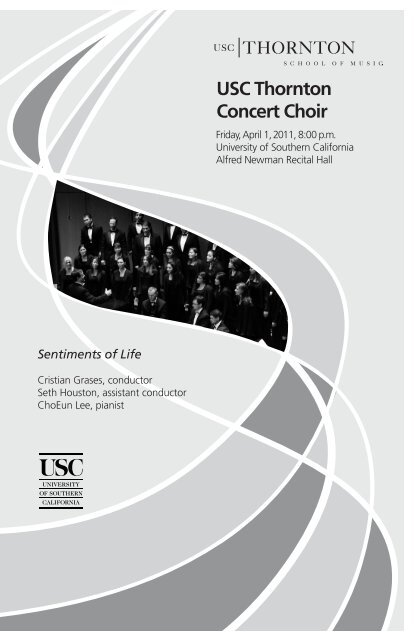
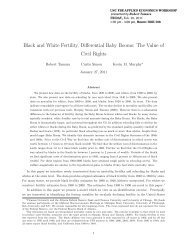

![15. RS 1.003 (RaJsu-yeni - nql?) RS 18.056 (RaJsu-yeni -5'[ ... ])](https://img.yumpu.com/51622603/1/189x260/15-rs-1003-rajsu-yeni-nql-rs-18056-rajsu-yeni-5-.jpg?quality=85)
